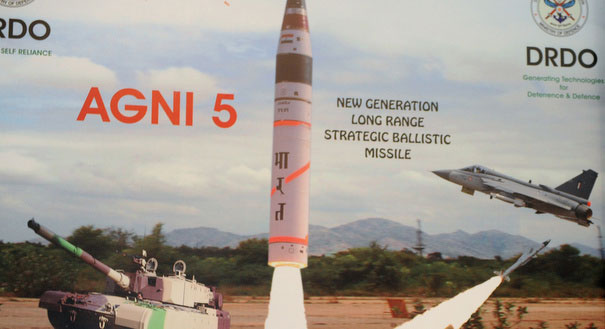Registration
You will receive an email confirming your registration.
IMGXYZ3852IMGZYXThe successful test launch of India’s Agni-V brought China’s power centers of Beijing and Shanghai into missile range, and the Sino-Indian deterrence relationship into new territory. China’s anti-satellite test and both countries’ advances in ballistic missile defense have intensified this trend, leading some to worry that a space race may be forming. At the tenth event of the “Arms Control Seminar Series” and the fifteenth installment of the “China-South Asia Dialogues” seminar series, held at the Tsinghua Politics and International Relations International Community Conference, experts and students from the China Reform Forum, China Arms Control and Disarmament Association, Beijing Electronic Science and Technology Vocational College, Beijing Foreign Affairs University, Beijing Language and Culture University, and the China University of Political Science and Law gathered to discuss this new Sino-Indian frontier. Carnegie’s Lora Saalman moderated and presented.
Aerospace Beginnings
- India's History: One Chinese participant noted how India’s program has long been connected with the country’s leadership. It began under the first Indian Prime Minister, Jawaharlal Nehru. It extended into the presidency of A.P.J. Abdul Kalam, who prior to his term as president worked as an aerospace engineer and was known as the “Missile Man of India” for his work on the development of India’s ballistic missile and launch vehicle technology.
- A High Priority: According to the experts present, India’s commitment to aerospace development has been long in the making and in some ways a greater priority than in China. So while they generally agreed that China has a more advanced aerospace program, they did not discount Indian advances and potential gains in aerospace technology.
Comparing without Competing
- India's Achievements: One of the Chinese experts emphasized that while China and India may be compared in terms of their aerospace advances, no competition exists. The expert characterized India’s Agni-V test launch and other aerospace pursuits as part of Nehru’s call for India to become a great country with an influential voice (yousheng youse de daguo) in the international community. The increasingly indigenous nature of these scientific advances, built from the contributions from Russia, Israel, and now the United States, are part of this evolution, he said.
- Indigenous Development: One Chinese participant highlighted the impact of the sanctions regime, noting that both China and India once faced restrictions by the West. Currently, however, the United States is likely to play a strong role in India’s future technological advances, he argued. India has much greater access to technology, equipment, and capabilities that could accelerate its aerospace advances, in his view. In response, a Chinese expert noted that indigenous production is essential for India to make long-term, sustainable progress, arguing that countries like the United States actually helped China’s development by forcing it to be self-reliant.
- Clear Connections: One Chinese expert emphasized that India's Defence Research and Development Organisation Director General V.K. Saraswat has mentioned China during discussions of his country's ballistic missile defense (BMD) and potential anti-satellite (ASAT) programs, demonstrating that China does have an the impact on India’s aerospace planning and vice versa. This expert further noted that India’s advances in satellites, ballistic missile defenses, etc. demonstrate that while there is a tendency for rhetorical exaggeration among experts like Saraswat within India, it is a country with a strong aerospace program (hangtian qiangguo).
Tensions and Tendencies
- Strategic Calculations: One Chinese expert described three primary issues as likely to cause tensions between China and India: territory, Tibet, and trade. He added, however, that China poses no threat to India and the latter has no desire to compete with or to challenge China. Another Chinese participant took issue with this characterization, asserting that as two rising powers, both China and India will invariably factor into each other’s strategic calculus, potentially leading towards greater competition. He argued that India is a country with great national ambition (daguo xiongxin) and its aerospace advances are a threat to China in part due to the potential for unpredictability (bu ke queding xing).
- Strengthened Political Will: Although greater aerospace capabilities, particularly in terms of remote sensing and reconnaissance, could assist in Indian border monitoring, one Chinese participant questioned India's ability to achieve its goals, given its turbulent geopolitical environment and domestic decision-making apparatus. One of the Chinese participants suggested that India could use “China threat theory” (zhongguo weixielun) to justify its program and overcome some of its internal inefficiencies through strengthening political will. While noting that China and India are unlikely to engage in conflict, a Chinese participant pointed out that if a Sino-Indian arms race were to occur, the country that would most benefit would be the United States.
Rhetoric versus Reality
- Hidden Capabilities: Given the similarity of systems and the greater technical difficulty of striking a ballistic missile than a satellite in a fixed orbit, one Chinese participant contended that India’s BMD achievements belie a hidden (yincang) ASAT capability. This expert cited India’s four primary motivators for developing these systems:
- conducting strategic containment of Pakistan;
- counterbalancing China;
- becoming a military and global great power; and
- promoting scientific advances within India.
- Impacting Discourse: A U.S. participant examined how India's BMD achievements, both actual and rhetorical, have affected the discourse within China. The attendee noted that India has overtaken Japan and South Korea in terms of Chinese coverage on ballistic missile defense, with a marked increase in interest since 2007. There has also been a shift of attention within China from the scientific to the strategic community, leading this expert to detail advantages, disadvantages, and recommendations:
- Advantages: Increasing pathways of Sino-Indian interaction, forcing Chinese experts to take India more seriously, and bringing them to the table to discuss capabilities;
- Disadvantages: Heightening Chinese strategic misperceptions and hard-line assessments of Indian capabilities and intent;
- Recommendations: Fostering greater bilateral engagement of the Chinese and Indian technical communities to provide a stronger foundation for discussion of actual capabilities, rather than rhetorical fears.
